I have decided to, for various reasons, open an individual blog here. I was an author for a website called Domus Ludorum, but my fellow authors abandoned the project, and the site came under heavy attack from spammers. I tired of trying to combat the spam with limited administrative privileges, and of being the sole source of content on what was meant to be a five person endeavor. So I am transferring some content here, with the intention of following through with new content once that is complete. These are the Games of My Life.
This blog is an ambitious, personal project as outlined below:
My goal is to post a game review of every game I have ever beaten in my life. Here's some answers to possible questions about the endeavor.
Q: What constitutes "beating" a game?
A: I am considering a game as beaten when it has been completed start to finish on (at least) the default difficulty setting, without cheating. For games that allow the player to continue playing after the story's ending, the story's ending will be considered to be the "finish" for the sake of this exercise.
Q: What constitutes cheating?
A: Cheating includes the use of cheat codes, glitch exploits, patch workarounds, save states, and et cetera. Save states are not always cheating, however. Many of the games I have completed have been played via emulator, as I have no access to many older game systems (much less their games). In these cases, if I must leave my computer for a while, I'd rather not leave my emulator running in the meantime. As such, I will use a save state and load it upon return, as a sort of extended pause feature. There are also a number of games that feature unlimited continues. In this case I will often use a save state at the spawn after a continue has been used (the idea being to simply skip the game over/continue screens and get right back to gameplay). Uses like these provide no gameplay advantage and are merely a convenience to the player - as such I do not consider them cheating.
Q: Does this potentially include any kind of video game at all?
A: No. Only games that can be beaten (or have all their story content completed) count. An MMORPG like World of Warcraft can never truly be beaten, and as such will never be on this list. An exception might be if the MMO ceases development and release of new content, in which case completing the highest challenge might be considered "beating" the game. This will be handled on a case-by-case basis, but is unlikely to occur. Furthermore, as a rule, only games that are or have been available for retail can apply. This includes full versions of old shareware games (the original
Doom was shareware, for instance), but does not include flash games or their derivatives, even if available as a purchased download. Browser games and internet games of that sort are therefore excluded, even in their full versions. There may be cases in which completing such a game is more of an achievement than completing a given retail game, but I needed a clear line and this was it.
Q: Why only include games you have beaten? Why not ones you've played a reasonable amount as well?
A: For one thing, that drastically increases the number of games I would need to review. For another, I believe that one can only get a full and complete sense of a game after actually completing it. If you have beaten a game I am reviewing, you will be comforted by knowing that I struggled through the same things you did and really understand what I'm talking about. If you haven't, my review is more reliable, as it comes from someone who has fully experienced this game and is not based solely on initial impressions.
Q: So how many games is this, anyway?
A: While at first the undertaking sounds intense, generally there is the sense afterward that "Well, how many games can that really be?" The fact of the matter is, most people who would call themselves gamers, even casually, have beaten a lot more games than they realize. The difference with me is that I've actually kept track, and have completed quite a bit. As of this post I have completed 225 games that match the above criteria, and this number is always rising (albeit slowly nowadays - the current number can be found on the blog's sidebar menu). So your first instinct was correct - this is a LOT of games to cover.
Q: What will be the format of these reviews?
A: I have settled into a comfortable format, I believe, with these reviews. The general format will be a coverage of the gameplay, the general plot, what stood out to me as good or bad about the game, and will feature probably on average 4-6 screenshots of gameplay (of me playing the game myself, when possible), complete with rollover text and captions. At the end there will be an overall score out of 20.
Q: Why out of 20? Why not 10, or 5?
A: A scale that rates out of 5 offers too little flexibility, I feel, in giving impressions of the game. An exception is when the scale increments every half point instead of every whole point (i.e. 3, 3.5, 4, etc). But then it is essentially utilizing a 10 point scale, and no longer a 5 point scale. Similarly, most reviewers utilize a 10 point scale that increments every half point, giving 20 ratings. I use the 20 point scale incrementing in whole numbers for the sake of uniqueness and to do away with the half point system.
Q: Is 10 the average score then?
A: Probably not. A game receiving 10/20 is completely mediocre. There is nothing special to recommend it, and its shortcomings aren't so severe as to make it painful to play. The average score according to my calculations thus far is 14/20. This is due to a couple reasons. For one, game companies are more accountable now. In the 80s, companies could release anything and if it was well marketed, it would probably sell. Think terrible games with movie tie-ins, that sort of thing. Now there is easy access to multiple reviews of any game, often a day or two before its actual release. Consumers are better avoiding awful games, so companies are making a higher quality of product on average. Secondly, because this is a list of games I have
beaten, many times if a game is not very good, I will not complete it. There are exceptions, of course. But I generally don't seek out terrible games to play and finish, and the scores reflect that.
Q: Is there some sort of order to how these reviews will be released?
A: Yes and no. I will strive to avoid overloading a certain genre or time period with successive reviews. That is, doing 15 reviews in a row of NES games likens me to a retro reviewer, and doing 8 shooters in a row gets boring for me and you both. I will attempt to vary the order of reviews to keep things relatively fresh, although I have beaten more "old" games than newer ones in general.
Q: What about games in a series? Will you follow any chronology?
A: Mostly yes. I will follow the chronology of the games (or in some cases of their release dates) when reviewing games in the same series. This means I will review
Mega Man 1 before any other Mega Man game, for instance. However, I will not review multiple Mega Man games in a row. For a series like the Final Fantasy series, I will address the "numbered" games in their order, but the spinoff games (Tactics, Crystal Chronicles, etc) are fair play at anytime, as they do not fit into the core chronology of the whole. Unfortunately this also means you may have to wait on me to finish certain games! For instance, to return to the FF series, I have beaten the original
Final Fantasy on the NES. I've also completed many of the later numbered games. However, I have never beaten Final Fantasy II (mainly because it's really not good...really). So I'll have to get around to playing and finishing that one before I can throw up reviews of the later games.
Q: Why does it matter that much to not sway from that order?
A: For a game series with storylines that overarch through multiple installments, the need is obvious. For games like Final Fantasy or Mega Man, the need is not there from that particular angle. However, I feel there is a lot of value in "building up." That is, usually new installments of game series add new features to the series bit by bit as the games progress. It serves the review format better and creates less confusion to simply discuss how the game differed from the previous one (and allows a closer appreciation of the changes), than to spend a paragraph every time relating the features of all the games surrounding it and where it fits in.
Q: What's the timetable for the release of these reviews?
A: The first few ones should come out by the end of June 2009, I'd expect. After that, I'm not holding myself to any given timetable for releasing them. I'm not going to say once a week or twice a month or anything, because I don't know what my schedule will look like, what my motivation will be like, and so forth. The reviews will come out when I churn them out, whenever that may be.
Q: So we just have to check back here every day to see?
A: Ayup. Bookmark it. Takes two seconds to check each day.
Q: What about reviews of things other than games?
A: I don't intend to review anything other than games on this site. The idea is to establish a review database of all these games, and attempting to branch into other content would cloud that somewhat. There is a chance I might do other game-related things, but don't count on it. The reviews are the point of this site and it's best to keep focused.
 First things first. Choose a career. With unparalleled customization, you can be a carpenter from Ohio, or even a farmer from Illinois. This choice will have a drastic impact on your gameplay, determining just how well you might be able to repair wagon wheels, or collect fruit. As if this wasn't enough, you then proceed to name your entire wagon party. Any name you wish. Finally, you can even choose what time of the year you want to leave for Oregon. Even the weather is at your command!
First things first. Choose a career. With unparalleled customization, you can be a carpenter from Ohio, or even a farmer from Illinois. This choice will have a drastic impact on your gameplay, determining just how well you might be able to repair wagon wheels, or collect fruit. As if this wasn't enough, you then proceed to name your entire wagon party. Any name you wish. Finally, you can even choose what time of the year you want to leave for Oregon. Even the weather is at your command!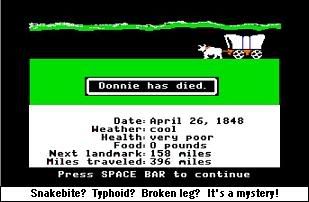 As you travel the trail, you'll encounter hardship after hardship. From broken legs to disease, from the savages whose land you're stealing to deteriorating wagon axles, this game has it all. Don't expect your entire family to make it to Oregon. I promise at least one of them will die. Probably more. And if you think you're making it without getting 50% of your possessions robbed from you along the way, well my friend. You have quite the surprise in store.
As you travel the trail, you'll encounter hardship after hardship. From broken legs to disease, from the savages whose land you're stealing to deteriorating wagon axles, this game has it all. Don't expect your entire family to make it to Oregon. I promise at least one of them will die. Probably more. And if you think you're making it without getting 50% of your possessions robbed from you along the way, well my friend. You have quite the surprise in store.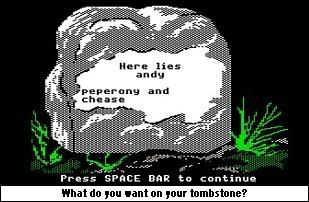 Eventually, hopefully, you reach Oregon itself. Along the way you'll have ended up doing a lot of river crossing, for better or for worse, but primarily you'll have spent many a day hunting. Hunting is perhaps the chief reason Oregon Trail is played. What better illustrates the American independent spirit than walking out into the untamed wilderness with a rifle and killing off the rest of the bison in the country? If that ain't patriotic, I don't know what is.
Eventually, hopefully, you reach Oregon itself. Along the way you'll have ended up doing a lot of river crossing, for better or for worse, but primarily you'll have spent many a day hunting. Hunting is perhaps the chief reason Oregon Trail is played. What better illustrates the American independent spirit than walking out into the untamed wilderness with a rifle and killing off the rest of the bison in the country? If that ain't patriotic, I don't know what is. 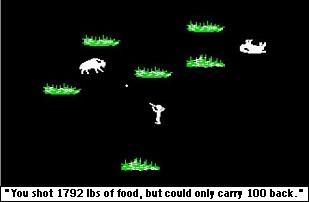 It's also easily the most fun thing to do in Oregon Trail, as the rest of the game generally consists of you watching an ox plod along, occasionally finding out that there is inadequate grass, or a poorly marked trail, or that Michael has died of a fever. Hunting tosses all that aside, giving you complete control over yourself as you can turn in a whopping eight directions to shoot prey that probably has no business being in the area of the country you are travelling. And of course, no matter how well you hunt, you're only as good as how much you can bench.
It's also easily the most fun thing to do in Oregon Trail, as the rest of the game generally consists of you watching an ox plod along, occasionally finding out that there is inadequate grass, or a poorly marked trail, or that Michael has died of a fever. Hunting tosses all that aside, giving you complete control over yourself as you can turn in a whopping eight directions to shoot prey that probably has no business being in the area of the country you are travelling. And of course, no matter how well you hunt, you're only as good as how much you can bench.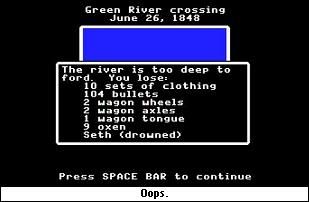 Lastly, Oregon Trail is educational. It teaches you what life (and death) was really like for the pioneers of the west. Coonskin caps, covered wagons, and all the cholera you can eat are the orders of the day, and Oregon Trail delivers them in spades, giving you a real feeling that you're actually there, experiencing it all, no longer able to control your bodily functions. Its stunning graphics and crystal clear sounds immerse you in the environment of 19th century America like no other game could ever do. The game even opens with an information screen daring you to feel the reality of it all course through your veins.
Lastly, Oregon Trail is educational. It teaches you what life (and death) was really like for the pioneers of the west. Coonskin caps, covered wagons, and all the cholera you can eat are the orders of the day, and Oregon Trail delivers them in spades, giving you a real feeling that you're actually there, experiencing it all, no longer able to control your bodily functions. Its stunning graphics and crystal clear sounds immerse you in the environment of 19th century America like no other game could ever do. The game even opens with an information screen daring you to feel the reality of it all course through your veins.  <--
<--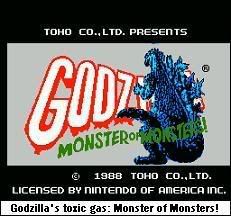 Godzilla is designed to be a side-scrolling action game. While it succeeds at the side-scrolling, it comes up remarkably short in the "action" category. The plot is that the race of beings inhabiting Planet X - that supposed 'bonus' planet in our solar system - have somehow assembled an army of space monsters. 'Space monsters' is, I'm told, the proper scientific terminology here. The denizens of Planet X want to invade Earth with this army. While it's not clear in the least what their motives are, they sure are dogged about it.
Godzilla is designed to be a side-scrolling action game. While it succeeds at the side-scrolling, it comes up remarkably short in the "action" category. The plot is that the race of beings inhabiting Planet X - that supposed 'bonus' planet in our solar system - have somehow assembled an army of space monsters. 'Space monsters' is, I'm told, the proper scientific terminology here. The denizens of Planet X want to invade Earth with this army. While it's not clear in the least what their motives are, they sure are dogged about it.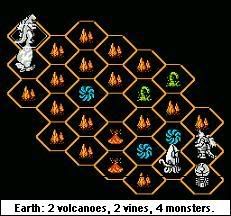 As you can see at left, the map of the Earth is incredibly detailed and accurate. Godzilla can move two hexes per turn, while Mothra can cover four. What hex you land on determines the kind of terrain you'll encounter...partially. But more on that in a bit. See those two other monsters down at the bottom right? Them's your "bosses."
As you can see at left, the map of the Earth is incredibly detailed and accurate. Godzilla can move two hexes per turn, while Mothra can cover four. What hex you land on determines the kind of terrain you'll encounter...partially. But more on that in a bit. See those two other monsters down at the bottom right? Them's your "bosses."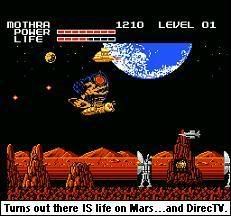 The maps themselves are supposed to represent the planets. You progress from Earth outward in the solar system, such that completion of the Earth map takes you to the Mars map, and so forth. Every planetary map brings more of the same. The levels look basically like what you see at right, regardless of the planet. I wish I could even say that each planet simply offered a palette swap of the basic level to distinguish them, but palette swaps happen completely at random in this game. Occassionally levels will also have you fight large brain mushroom things, whatever they're supposed to be.
The maps themselves are supposed to represent the planets. You progress from Earth outward in the solar system, such that completion of the Earth map takes you to the Mars map, and so forth. Every planetary map brings more of the same. The levels look basically like what you see at right, regardless of the planet. I wish I could even say that each planet simply offered a palette swap of the basic level to distinguish them, but palette swaps happen completely at random in this game. Occassionally levels will also have you fight large brain mushroom things, whatever they're supposed to be.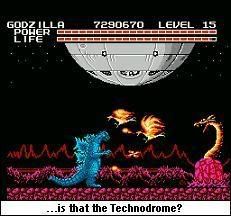 You'll encounter a variety of non-boss enemies throughout your planetary romps, but this is by no means a good thing. Enemies are so strange and random that the game never finds any sense of self-consistency or personality. You'll fight anything and everything that is animated. This includes the expected, such as tanks and aircraft, to the wholly absurd. Things like punching a volcano to make it explode, or a pillar of planetary crust that keeps bouncing up and down, or flame-launching totem poles. Most infuriating, there's this one fireball-ish enemy that not only cannot be killed in any way, but also seeks you and when it hits, does so repeatedly until it leaves the screen, often killing you at early stages. There are no continues.
You'll encounter a variety of non-boss enemies throughout your planetary romps, but this is by no means a good thing. Enemies are so strange and random that the game never finds any sense of self-consistency or personality. You'll fight anything and everything that is animated. This includes the expected, such as tanks and aircraft, to the wholly absurd. Things like punching a volcano to make it explode, or a pillar of planetary crust that keeps bouncing up and down, or flame-launching totem poles. Most infuriating, there's this one fireball-ish enemy that not only cannot be killed in any way, but also seeks you and when it hits, does so repeatedly until it leaves the screen, often killing you at early stages. There are no continues. At least the two playable characters are themselves reasonably different. Godzilla moves slowly, but has a lot of power, and can attack high, medium, or low. He is also able to jump and duck, though his size prevent these from being incredibly useful most of the time. His special move (fueled by "POWER," as you can see) is his atomic breath, which pretty much kills anything it hits. Mothra, on the other hand, is much quicker and more agile. She takes up less space and is harder to hit, but does significantly weaker damage. She also is able to fly over much of the terrain and drop bombs, or poison darts, or spore, or larvae, or whatever you want to call those weird blue pixelated things, down upon her foes.
At least the two playable characters are themselves reasonably different. Godzilla moves slowly, but has a lot of power, and can attack high, medium, or low. He is also able to jump and duck, though his size prevent these from being incredibly useful most of the time. His special move (fueled by "POWER," as you can see) is his atomic breath, which pretty much kills anything it hits. Mothra, on the other hand, is much quicker and more agile. She takes up less space and is harder to hit, but does significantly weaker damage. She also is able to fly over much of the terrain and drop bombs, or poison darts, or spore, or larvae, or whatever you want to call those weird blue pixelated things, down upon her foes.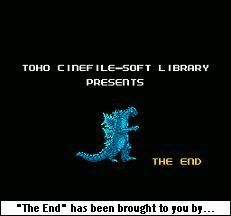 All in all, the tediously repetitive gameplay is enough to make you either quit the game altogether or kill yourself along the way. Even the ending sucks. Before you reach the inane screen to the left, you are treated to a wall of text explaining a note that the defeated civilization of Planet X has left. It states something along the lines of "We got beaten because Godzilla is more powerful than we thought, but don't worry, we'll be back." It would be terrible enough if it was left at a simple cliffhanger sort of thing like that, because this game should never, ever see a sequel. But the Planet X-ians went on to insist that they would never give up their dreams to invade Earth, and even if it took eons, would form a new space monster army to do so. All this is being said as they settle on a new world in another solar system.
All in all, the tediously repetitive gameplay is enough to make you either quit the game altogether or kill yourself along the way. Even the ending sucks. Before you reach the inane screen to the left, you are treated to a wall of text explaining a note that the defeated civilization of Planet X has left. It states something along the lines of "We got beaten because Godzilla is more powerful than we thought, but don't worry, we'll be back." It would be terrible enough if it was left at a simple cliffhanger sort of thing like that, because this game should never, ever see a sequel. But the Planet X-ians went on to insist that they would never give up their dreams to invade Earth, and even if it took eons, would form a new space monster army to do so. All this is being said as they settle on a new world in another solar system. Now, I know what all of you are thinking. "Who in the world is Dazzler?" To be honest, I've beaten this game numerous times and I still have no idea. She's kind of like a blonde Jubilee with a marginally more useful mutant power. Anyway, you and your friends (should you have any) are charged by Professor X with the task of, well, see above.
Now, I know what all of you are thinking. "Who in the world is Dazzler?" To be honest, I've beaten this game numerous times and I still have no idea. She's kind of like a blonde Jubilee with a marginally more useful mutant power. Anyway, you and your friends (should you have any) are charged by Professor X with the task of, well, see above.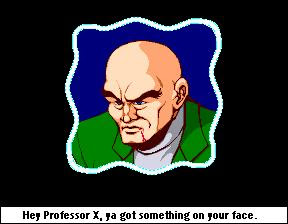 <--- br="">
<--- br=""> Of course, none of them really hold a candle in my book to Colossus, the only real man of the bunch. Biceps of steel. Literally. The programmers of the game realized that his mutant power didn't extend beyond his steel skin, so pressing the mutant power button wouldn't really do much good. At a loss, they decided to simply have him flex and roar, causing anything in the vicinity to explode.
Of course, none of them really hold a candle in my book to Colossus, the only real man of the bunch. Biceps of steel. Literally. The programmers of the game realized that his mutant power didn't extend beyond his steel skin, so pressing the mutant power button wouldn't really do much good. At a loss, they decided to simply have him flex and roar, causing anything in the vicinity to explode. But then there's the plot. Or, at least, I think it's a plot. Actually, I'm not really sure what's going on at any point during the entire game. At first, there is simply an army of mini-Sentinels attacking some city, and it's your job to stop them. Ok, cool. You kill a couple classic X-Men villains along the way, shut down the robot factory, all good. But then Professor X gets kidnapped and you have to travel to some jungle island to save him. And here you get more mini-Sentinels, as you soon discover every level will simply palette swap them and call it a new enemy. The final level featured golden ones, apparently to indicate their supposed "difficulty" to dispatch.
But then there's the plot. Or, at least, I think it's a plot. Actually, I'm not really sure what's going on at any point during the entire game. At first, there is simply an army of mini-Sentinels attacking some city, and it's your job to stop them. Ok, cool. You kill a couple classic X-Men villains along the way, shut down the robot factory, all good. But then Professor X gets kidnapped and you have to travel to some jungle island to save him. And here you get more mini-Sentinels, as you soon discover every level will simply palette swap them and call it a new enemy. The final level featured golden ones, apparently to indicate their supposed "difficulty" to dispatch.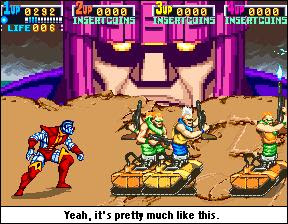 Later, when it seems like you're making headway, and it seems like the game has fully embraced its own personality, you are given a new telepathic order. "X-Men, X-Men! Magneto is planning to attack Earth from his asteroid base. You must foil his plan before it's too late. Go after the giant Sentinel!" And just like that, the game degenerates into another let's-fight-in-space-because-it's-the-future sort of thing. It seems to be the fallback for when designers run out of ideas but need to crank out some more gameplay time.
Later, when it seems like you're making headway, and it seems like the game has fully embraced its own personality, you are given a new telepathic order. "X-Men, X-Men! Magneto is planning to attack Earth from his asteroid base. You must foil his plan before it's too late. Go after the giant Sentinel!" And just like that, the game degenerates into another let's-fight-in-space-because-it's-the-future sort of thing. It seems to be the fallback for when designers run out of ideas but need to crank out some more gameplay time. Upon defeating Magneto, you are told that you have had success and saved the Earth, but that wait! The game is not over yet. Expecting some sort of dramatic epilogue, you wait somewhat eagerly for your new challenge, only to find that you're now back at the beginning of the first level! Now it'd be one thing if this happened
Upon defeating Magneto, you are told that you have had success and saved the Earth, but that wait! The game is not over yet. Expecting some sort of dramatic epilogue, you wait somewhat eagerly for your new challenge, only to find that you're now back at the beginning of the first level! Now it'd be one thing if this happened